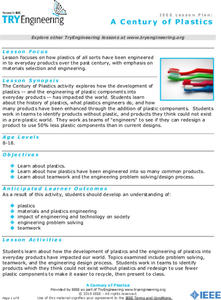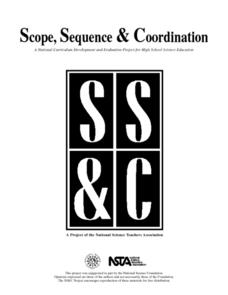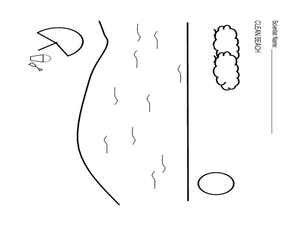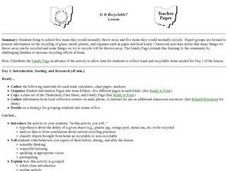Curated OER
Sorting Plastics For Recycling
First, young chemists practice polymer identification by density and flame tests. With the data collected, they propose a method of separating polyethylene from other plastics and determine what property makes it desirable for recycling....
Curated OER
Materials
This interactive presentation is a visual delight for young eyes! The title slide allows you to click on one type of material: wood, fabric, plastic, metal, or paper. You are then taken to a slide to consider numerous objects and...
Institute of Electrical and Electronics Engineers
A Century of Plastics
After reading about polymer materials, engineer trainees examine how plastics have been integrated into everyday products. In groups, they compile a list of products made entirely without plastics and then, as a closing activity, try to...
Curated OER
Venn Diagrams
The Venn diagram is an important graphic organizer, and learners should be familiar with it. Here, pupils compare things that are made of plastic and metal, and they identify the things that have both substances in them. There are two...
Curated OER
Investigation of Crystallinity in Polymeric Materials
A kaleidoscope is constructed using polarizing polymer paper and then low-density polyethylene, high-density polyethylene, and polypropylene are all melted onto individual glass slides and examined through a microscope. The intent is to...
Curated OER
Polymers
Present polymers to your chemistry class with this practical PowerPoint. Begin with a definition and the properties of polymer materials. Branch out into diagrams of polymer structure. Consider the two general types: addition polymers...
Curated OER
Oils and Plastic
Peruse the properties of polymers with your materials engineers, chemistry aces, or emerging ecologists. The inquiries in this resource include puncturing polyethylene plastic bags, dissolving polystyrene cups, creating a polymer...
Curated OER
Materials - Who Wants to Be a Millionaire?
Play a game to review characteristics of different materials. Players will compare natural to man-made materials and how much light passes through them. They consider water and heat resistance as well. If you are preparing your class for...
Curated OER
What Are They Made Of?
After a lesson on scientific materials, your ESL students can practice their knowledge by matching nine pictures to their corresponding materials (windows to glass, etc). Additionally, students can compose their own sentences using these...
Curated OER
Fish Hazards
Students study the Pacific salmon and see the different challenges they face. In this environment lesson students complete several activities that show how humans have affected the salmon environment. These activities have varying...
Curated OER
Applied Science - Built Environment Lab
Students evaluate trash. In this Science lesson, students collect and weigh trash from their classrooms. Students categorize the trash and the corresponding weights, recording the information on a data sheet.
Curated OER
Polystyrene Containers
Students conduct experiments to determine the effectiveness of polystyrene containers at preventing heat loss. In this polymers lesson, students design an experiment to determine how effective Styrofoam burger containers are at...
Curated OER
Where Do Things Come From?
Second graders examine the recycling process. In this recycling lesson, 2nd graders discuss the reasons for recycling and create storyboards to show where a specific material comes from. Students complete a worksheet as a follow-up...
Curated OER
WS 10.9 Plastic Recycling
In this recycling worksheet, students search for as many types of plastics categorized with the resin identification codes and fill in a chart for each plastic type. They identify the product name, the category the plastic is in, the...
Curated OER
Thermoset Polymers
Students complete a lab activity with polymers to allow them to better understand how to make "observations". In this science lesson students make measurements and collect data.
Curated OER
Plastic Packaging
Students collect data. In this math lesson, students collect data about recyclable materials. Students develop a plan that will help the environment. Recycling plastic containers is discussed.
Curated OER
Recycling Worksheet
In this recycling worksheet, students sort recycling items into paper, plastic, or aluminum bins. Students sort 7 items total on this worksheet.
Curated OER
Industrial Processes of Polymers: How toys Are Made
Students explore how technology and science have created the plastics that make toys. In this industrial processes lesson students work on their own injected molded product and a blow molded product.
Curated OER
You Are What You Eat: Plastics and Marine Life
Young scholars study the different types of plastics and see which ones sink or remain buoyant. In this ocean environmental lesson students complete several handouts, and view a film on PBS.
Curated OER
The Polymer Schoolhouse
Students study various objects and determine plastic and non-plastic. In this creative lesson students get into groups and create a diorama to show the different properties they discovered.
Curated OER
Mysterious Magic
In this salt moving worksheet, students move salt with rubber bands, plastic, cans, and more, but don't touch it. Students follow 5 directions and answer 2 questions, and relate this to sound waves.
Curated OER
Plastic Polymers
Learners learn about plastic. In this plastic polymers lesson, students examine the properties of plastic, its variety of uses and how it is recycled.
Curated OER
Simply Sediments
In this earth science activity, students use a plastic bottle and sediments from their community to create a sediment bottle. They identify what types of sediments they locate. Students also identify which ones float and which ones move...
Curated OER
Is It Recyclable?
Students bring to school five items they would normally throw away and five items they would normally recycle. Expert groups are formed to present information on the recycling of glass, metal, plastic, and organics such as paper and...

























